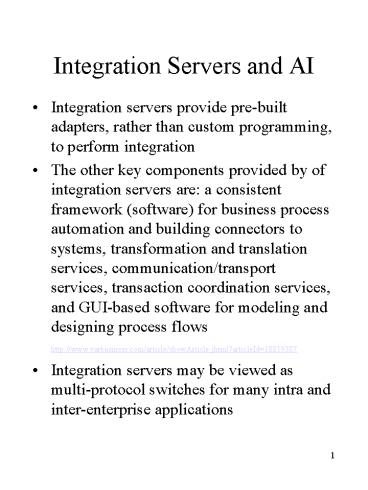Integration Servers and AI - PowerPoint PPT Presentation
1 / 13
Title:
Integration Servers and AI
Description:
... repository services, directory services, management, and APIs and adapters. ... Applications may continue to invoke existing APIs for integration. ... – PowerPoint PPT presentation
Number of Views:50
Avg rating:3.0/5.0
Title: Integration Servers and AI
1
Integration Servers and AI
- Integration servers provide pre-built adapters,
rather than custom programming, to perform
integration - The other key components provided by of
integration servers are a consistent framework
(software) for business process automation and
building connectors to systems, transformation
and translation services, communication/transport
services, transaction coordination services, and
GUI-based software for modeling and designing
process flows http//www.varbusiness.com/article/s
howArticle.jhtml?articleId18819387 - Integration servers may be viewed as
multi-protocol switches for many intra and
inter-enterprise applications
2
(continued )
- Integration servers can be set up easily to
broker information between a variety of
source-target entities, taking into account
differences in application semantics, database
schemas, and process information - The services included in integration servers are
transformation, intelligent routing, rules
processing, message warehousing, flow control,
repository services, directory services,
management, and APIs and adapters.
3
(Continued )
- Integration servers provide a layer on top of
existing middleware a sort of middleware of
middleware thus enabling more comprehensive and
effective solutions - The three primary components of integration
servers are transformation layer, rules engine
and the intelligent routing mechanism - The asynchronous store-and-forward messaging
allows for producer-consumer (publish/subscribe)
message flows
4
Message Brokering
- Source-target systems may remain anonymous.
Brokering also accomplishes data translation and
conversion, reformatting, reconstituting, and
routing to any number of targets based on
business rules
5
API and Adapters
- Applications may continue to invoke existing APIs
for integration. The integration server adapter
renders it into a form that the server
understands. The adapters also publish
information to the target application in a form
that the target application can understand
6
Transformation Layer
- Transformation layer performs source-target
message translations on the fly. It provides a
common dictionary containing information on how
each application communicates outside itself, as
well as which bits of information have meaning to
which applications. - Transformation has parsing and pattern-matching
methods for describing structure of message
formats
7
Schema Conversion
- Schema conversion takes into account the
differences between application semantics, and
performs the translations dynamically
8
Data Conversion
- Rules-based (algorithms or look-up tables)
conversions of data formats, e.g. numeric to
character, and vice versa. Conversions need to
take into account many different formats such as
character, binary integers, floating-point
numbers, bit fields, IBM mainframe floating
points, COBOL and PL/I picture data, BLOBs, etc.
9
Intelligent Routing
- Content-based routing or flow control making use
of rules and message information, identifying the
message source, and routing it to appropriate
targets
10
Rules Processing and Message Warehousing
- The rules processing engine allows architects and
developers to create rules that control the
processing and distribution of information,
taking into account the differences in formats,
and message destinations based on contents - Rules may be described using scripting languages
and applied interpretively - Message Warehousing is a database allowing for
message persistency for subsequent analysis,
summaries. extraction, integrity, archiving, and
auditing in terms of conformity to business rules
11
Repository Services
- Repository is a database of information about
source and target applications, with information
such as the following - Owner of System (company)
- Location of the system (directory)
- Security parameters
- Message schema information
- Metadata
- Enabling technology
- Transformation information
- Rules and logic for message processing
- Design and architecture information, e.g. UML
- Object information
12
User Interface
- Integration servers are GUI based, often
point-and-click type environments, simplifying
the application integration process - Integration servers also provide administrative
features such as monitoring the message traffic,
performance of integration servers, status of
connected systems, etc.
13
Integration Server Topologies
- Conventionally, the servers have used
hub-and-spoke topology, with server at the hub
and applications forming the star, with one hub
or more hubs for flexibility in terms of hub
types and scalability in terms of total number of
application systems, and fail safe service































